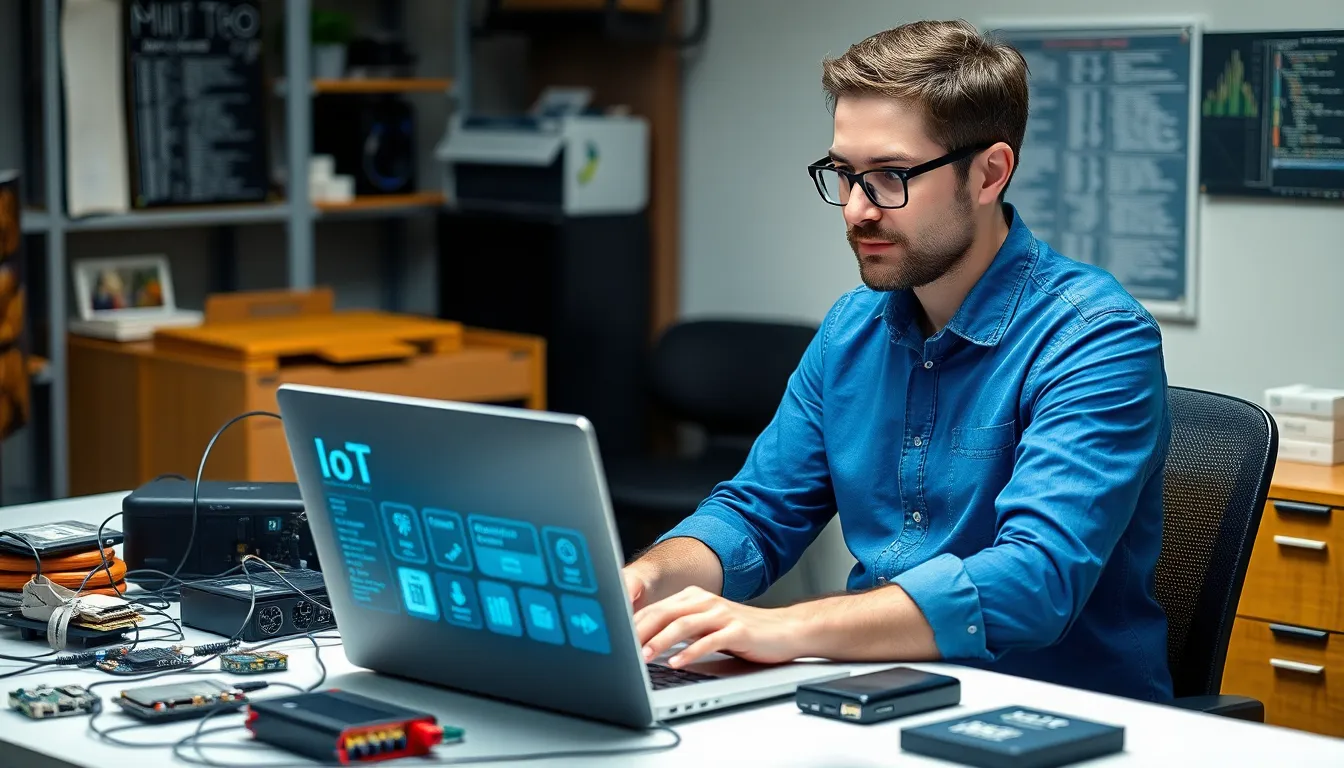In today’s tech-driven world, the Internet of Things (IoT) is revolutionizing how devices connect and communicate. From smart homes to industrial automation, IoT coding plays a crucial role in turning innovative ideas into reality. As more devices become connected, the demand for skilled coders who can navigate this complex landscape is skyrocketing.
Understanding the fundamentals of IoT coding opens doors to endless possibilities. It empowers developers to create applications that enhance efficiency, improve user experiences, and drive sustainability. With the right knowledge and tools, anyone can embark on a journey to harness the power of IoT, making it an exciting field for both seasoned programmers and newcomers alike.
Table of Contents
ToggleOverview of IoT Coding
IoT coding focuses on the development of software that enables devices to connect and communicate over the internet. This coding encompasses various programming languages, protocols, and frameworks tailored for the unique requirements of IoT devices. Key languages include Python, C, and JavaScript, known for their versatility and efficiency in handling multiple tasks.
Frameworks and platforms like Node-RED and Arduino IDE support IoT development by simplifying complex processes. These tools allow developers to create applications that interact with sensors and actuators, providing seamless communication between devices in real time. Understanding protocols such as MQTT and HTTP is essential, as they enable efficient data transfer and ensure reliable device interactions.
Skillsets in IoT coding often include knowledge of cloud computing, security protocols, and data analytics. Familiarity with cloud platforms like AWS IoT or Microsoft Azure enhances developers’ ability to manage device data and deploy applications effectively. Security remains a critical focus, as it protects sensitive information and maintains user trust in IoT systems.
Developers interested in IoT coding should prioritize hands-on experience through projects, online courses, and community engagement. This practical exposure facilitates an understanding of the challenges and solutions involved in developing IoT applications. The demand for skilled IoT developers continues to rise, highlighting the importance of mastering the coding fundamentals in this rapidly evolving field.
Key Concepts in IoT Coding

Key concepts in IoT coding provide foundational knowledge crucial for developing IoT applications. These concepts include understanding IoT architecture and the significance of protocols tailored for device communication.
Understanding IoT Architecture
IoT architecture consists of multiple layers that facilitate seamless communication between devices. Each layer plays a specific role:
- Device Layer: Comprises the physical devices and sensors that collect and transmit data.
- Network Layer: Handles connectivity via various networks, including Wi-Fi, cellular, and Zigbee.
- Edge Computing Layer: Processes data at or near the source, reducing latency and bandwidth usage.
- Cloud Layer: Manages data storage, analysis, and remote access, allowing for enhanced scalability.
- Application Layer: Delivers user interfaces and application logic, enabling users to interact with IoT systems.
By understanding these layers, developers can create reliable and efficient applications that respond to real-time data.
Importance of Protocols in IoT
Protocols are essential for ensuring smooth and reliable communication between IoT devices. Key protocols include:
- MQTT (Message Queuing Telemetry Transport): Lightweight and efficient for low-bandwidth, high-latency networks, ideal for messaging between devices.
- HTTP (Hypertext Transfer Protocol): Standard for communication on the web, often used for RESTful APIs in IoT applications.
- CoAP (Constrained Application Protocol): Designed for low-power devices, it simplifies communication in resource-constrained environments.
Utilizing the right protocols enhances data transfer efficiency, optimizes device interactions, and improves overall system performance. Developers must familiarize themselves with these protocols to achieve effective IoT solutions.
Popular Programming Languages for IoT Coding
Understanding the right programming languages for IoT coding enhances development efficiency and device performance. Several languages stand out in this domain due to their versatility and functionality.
Python for IoT Development
Python serves as a highly favored language in IoT development due to its simplicity and extensive libraries. It supports various devices and platforms, making it ideal for rapid prototyping. Libraries like MicroPython enable the development of applications on microcontrollers, while extensive frameworks such as Flask and Django facilitate backend development. Its readability and intuitive syntax allow developers to focus on application logic rather than complex syntax, thereby reducing development time. Real-time analytics and machine learning integrations further cement Python’s role in data-intensive IoT applications.
C/C++ in Embedded Systems
C and C++ play a critical role in embedded systems within IoT applications. These languages offer direct control over hardware and efficient memory management essential for performance-critical applications. C/C++ provides the necessary speed and low-level access required for programming microcontrollers and sensors. The Arduino platform extensively uses C/C++ to enable hardware interaction through a simplified coding environment. Their ability to work with real-time operating systems and support low-level functions makes C and C++ indispensable for developing reliable and resource-efficient IoT devices.
Tools and Platforms for IoT Coding
A variety of tools and platforms exist to streamline the IoT coding process. Developers can leverage these resources to enhance their efficiency and optimize applications.
Development Environments
Development environments provide essential tools for coding, testing, and deploying IoT applications. Popular environments include:
- Arduino IDE: This platform simplifies programming for Arduino boards, enabling rapid development with an easy-to-use interface.
- PlatformIO: This open-source ecosystem supports multiple boards and platforms, providing a unified environment for managing libraries, code, and hardware.
- Visual Studio Code: Known for its versatility, this code editor offers extensions specifically tailored for IoT development, enhancing coding and debugging processes.
These environments allow developers to write code effectively, run simulations, and troubleshoot issues before deployment.
Frameworks and Libraries
Frameworks and libraries significantly enhance IoT development by providing reusable code and simplifying complex tasks. Key frameworks and libraries include:
- Node-RED: This visual programming tool simplifies wiring together devices, APIs, and online services effortlessly, enabling quick prototyping.
- MQTT.js: A client library for the MQTT protocol, it facilitates easy integration of MQTT with Node.js applications.
- TensorFlow Lite: Specifically designed for edge devices, this library allows developers to run machine learning models on IoT devices, enhancing data analysis capabilities.
Utilizing these frameworks and libraries accelerates application development while improving functionality and performance.
Challenges in IoT Coding
IoT coding presents several challenges that developers must navigate to create effective applications. These challenges often stem from the complexity of interconnected devices and the unique requirements of each project.
Device Compatibility
Device compatibility issues arise due to differing manufacturers and standards. Developers face diverse operating systems, protocols, and hardware specifications, making it crucial to ensure seamless communication between devices.
Security Concerns
Security remains a significant challenge in IoT coding. With increasing cyber threats, developers must implement robust security measures to protect sensitive data and ensure safe device interactions. Strong authentication processes, encryption, and regular updates are vital for minimizing vulnerabilities.
Data Management
Data management poses another challenge, as IoT devices generate vast amounts of data. Developers must implement strategies for efficient data storage, processing, and analysis. Utilizing cloud platforms like AWS IoT or Microsoft Azure can help manage this data effectively while ensuring scalability.
Network Reliability
Network reliability is vital for IoT applications. Developers must design systems that can handle unstable connections and intermittent drops in network availability. Implementing features like local data caching and synchronization can enhance reliability.
Resource Constraints
Resource-constrained environments present challenges in terms of memory, power, and processing capabilities. Developers often work with limited resources, requiring optimized code and efficient algorithms to maximize performance without draining device batteries.
Protocol Complexity
Understanding and implementing multiple communication protocols can be complex. Developers need to be familiar with a variety of protocols, including MQTT, HTTP, and CoAP. Each protocol has its own strengths and weaknesses, making it essential for developers to choose the most suitable one for their specific application needs.
Scalability Issues
Scalability concerns arise with the growth of IoT ecosystems. Developers must ensure that their applications can accommodate a growing number of devices without degrading performance. Designing scalable architectures from the outset can facilitate growth as new devices are added.
Addressing these challenges effectively enables developers to create robust and efficient IoT applications. By staying informed and skilled in the evolving landscape of IoT technologies, developers can contribute to the advancement of smart solutions in various sectors.
The future of IoT coding is bright and full of opportunities. As the demand for connected devices continues to rise, so does the need for skilled developers who can navigate the complexities of this field. Mastering IoT coding not only enhances career prospects but also empowers individuals to contribute to innovative solutions that improve efficiency and sustainability.
By embracing the key concepts and tools discussed, developers can position themselves at the forefront of this technological revolution. With hands-on experience and a commitment to continuous learning, they can tackle the challenges of IoT coding and help shape a smarter, more connected world. The journey into IoT coding promises to be rewarding for those ready to dive in.






